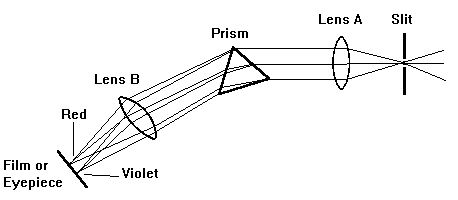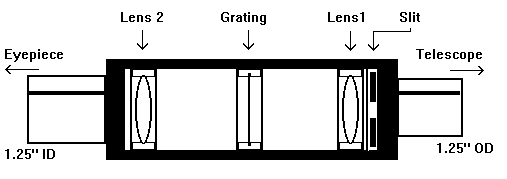Experiments in Spectroscopy - Putting Rainbows to Work
Jack Kramer

It is through spectroscopy that the concept of the "redshift" was developed. It was found that objects in space that are moving away from us have their spectra shifted toward the red end of the spectrum. In other words, the characteristic absorption lines would all be positioned correctly, except that they would all be moved toward the red. The faster the object is receding, the greater the shift. What happens is that as a luminous body recedes, the light it emits is stretched out, causing fewer vibrations to reach the observer in a second than if the body were stationary. The wavelengths of spectral lines are apparently lengthened. In the following illustration, the absorption lines are identical to a normal spectrum, except that all the lines are slightly shifted to the right (red).

Objects that are moving toward us would show the opposite effect, a shift toward the blue. It's possible to identify a baseline -- the "normal" spectrum of a star -- because the signature lines of certain elements, such as hydrogen and calcium, are always present and always in the same location.
The next step in understanding spectroscopy is knowing how a spectroscope works. (You'll also hear the term "spectrograph" used interchangeably -- this generally refers to a spectroscope that has a camera attached, in place of an eyepiece.) The following is a simple layout of the classical spectroscope.

Light from the object enters at the slit and the light rays are made parallel by passing through lens A. The prism bends the light by different amounts - red light the least, violet the most. The rays finally pass through lens B, which focuses the different colors on either an eyepiece for visual inspection, or onto film. Multiple prisms can be used to provide a wider separation of the colors. Actually, prisms have now been replaced by diffraction gratings -- transparent plates on which are etched thousands of very fine parallel lines which do the job of breaking up the light.
If spectroscopy has grabbed your interest, then you might be wondering what it takes to try it for yourself. The October 1995 issue of Sky & Telescope carried a favorable review of a star spectroscope from Rainbow Optics, 1593 E Street, Hayward, CA 94541. At a list price of $189, it'll set you back about as much as the cost of a really good eyepiece.
Based on the classical design, I built a spectroscope using a transmission diffraction grating in place of the prism. The grating is a piece of plastic film called Holex Kaleidaglas. The following diagram shows the placement of the components.

The lenses were refugees from the optical junk drawer; I thought that would be acceptable because you're looking for a spectral line, not a pinpoint image. The end result would have been better, though, had I used better lenses. The slit is made of two metal rectangles that slide back and forth in a channel. I discovered that when the slit is adjusted to a narrow opening, it reduces the brightness of the spectrum too much. Therefore, the opening is left about 1/2" wide -- in effect, it's not used at all. The spectrum produced is a narrow band, but it's too faint to show any features. This probably results from the loss of light caused by the two lenses.
A simplified method produced better results, so I'd suggest forgetting about building a classical spectroscope. A piece of transmission diffraction grating material can be used by itself. Simply cut out a circular piece of film and mount it in an unused colored filter cell that screws into the field lens end of an eyepiece. This produces a much brighter spectrum than the homemade spectroscope.
I tried four different types of film. Holex Kaleidaglas was the first one used, originally several years ago. It came from a pair of "rainbow glasses" purchased at the American Science Center in Chicago. For each object, it produces four bright spectra oriented at right angles to each other, and four fainter secondary spectra. Also, the spectra are fairly close to the object under observation. The drawback is that this film is the thickest of those tried, and it doesn't appear to be as optically uniform -- the spectral bands aren't quite as sharp as with the other films.
I then experimented with three other transmission-type diffraction gratings, each one producing two spectral bands oriented on opposite sides of the object. One is a piece of ruled diffraction film mounted in a slide holder; this version has 13,400 grooves per inch. However, the spectrum isn't bright enough to see any details on objects viewed through a telescope. Another diffraction grating film with 23,000 grooves per inch produces a much brighter spectrum. The problem here is that the dispersion pattern is such that the spectrum is quite far away from the object viewed. Therefore, this film can't be used on the field lens side of an eyepiece, but must be held over the eye lens side of the eyepiece where the peripheral view is wider. The spectrum is sharper than the Kaleidaglas, but using it over the eyepiece is awkward. Finally, I purchased a film that just this year became available at Edmund Scientific -- a holographic diffraction film with only 6000 grooves per inch. But the literature explains that this type reduces the amount of stray light, thus producing sharper diffraction orders over the other films, which are ruled. This does produce sharp spectral lines that lie fairly close to the object viewed.
With all the films, the spectral line shifts in and out of focus even with a slight movement of the eye. You find yourself constantly re-focusing the eyepiece. But prolonged, careful observing does reveal some details, since absorption lines pop in and out of view. Repeated observations have confirmed that the best results are obtained with high magnification (which provides a larger spectrum), a steady atmosphere, and telescope optics that have reached thermal equilibrium. However, the use of a Barlow lens makes the spectrum fainter; again, this may be a problem of adding too many lenses to the light path.
A down-to-earth test is to look through the film at a sodium vapor street light; you'll be amazed at the varied absorption and emission lines produced. But the real test is looking at an object in the night sky through your telescope. Using the transmission grating to detect characteristic hydrogen emissions of even the brightest planetary nebulae is disappointing -- there just isn't enough light to show a readable spectrum. But it works well enough on bright stars. I tested each film on three stars all in the same area of the sky -- Betelgeuse, Rigel, and Sirius. As one would expect, the spectrum of Betelgeuse predominated in the yellow to red end with several absorption lines, the darkest of these in the orange area. Rigel was less interesting; I think I saw some lines fleetingly. But the spectrum of Sirius showed obvious absorption lines in the blue and green. I later checked a picture of the spectrum of Sirius, and sure enough, there are large absorption features typical of A-type stars with strong hydrogen lines.
Another way to better see the spectra might be to take a color astrophoto using the diffraction grating. The greater color sensitivity of a long exposure on film would probably bring out considerably more detail and provide a usable spectrum where the human eye sees only a faint grayish blur.
All the diffraction grating films are available from Edmund Scientific in New Jersey; their phone number for ordering is 609-547-8880. Of the four different films, either the new holographic film or the lenses from the "rainbow glasses" produce the most useful spectrum. The cost of the holographic film is $10.00 for a 6"x12" sheet (stock # W52,990). But the "rainbow glasses" produced the brightest spectrum, which seems to be more important than sharpness of the spectral line. Edmund sells these for $6.95 per package of six glasses (stock # W42,319).
This diffraction grating "filter" won't provide enough detail to do meaningful research, but it's interesting to see actual absorption lines in bright stars. The lines don't jump right out; you have to take time to observe for awhile, and I found that atmospheric conditions play a big part in being able to see spectral features. If nothing else, it's interesting to realize we're looking at the very features that first told astronomers about the structure and composition of stars.





